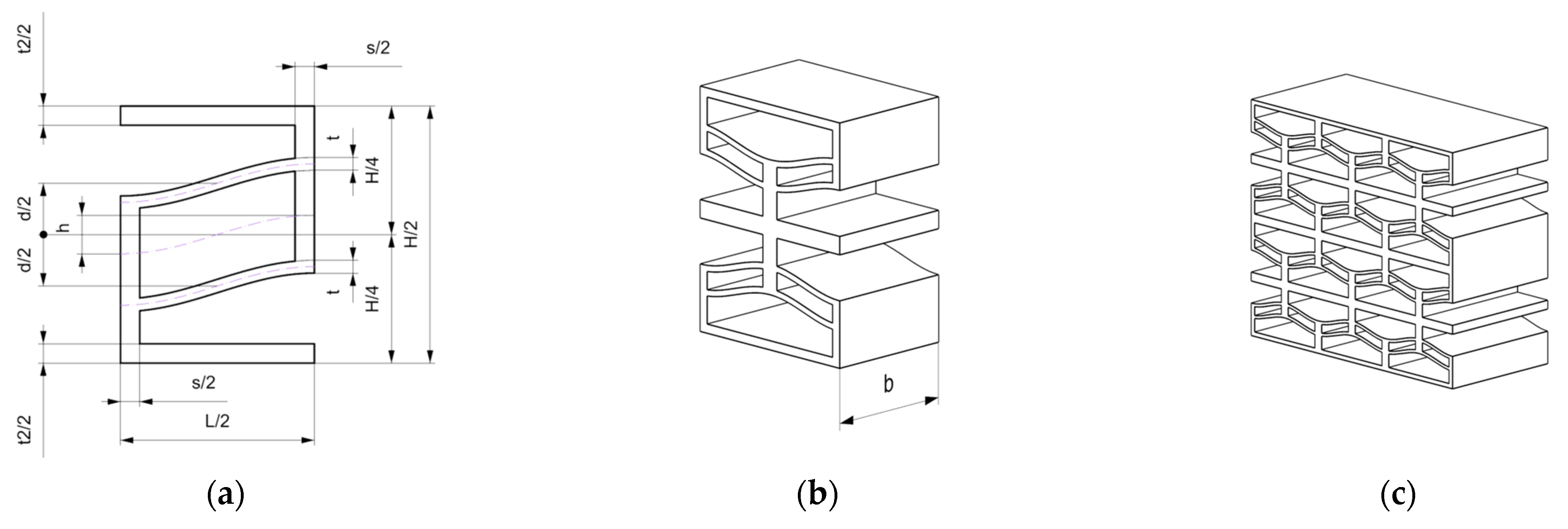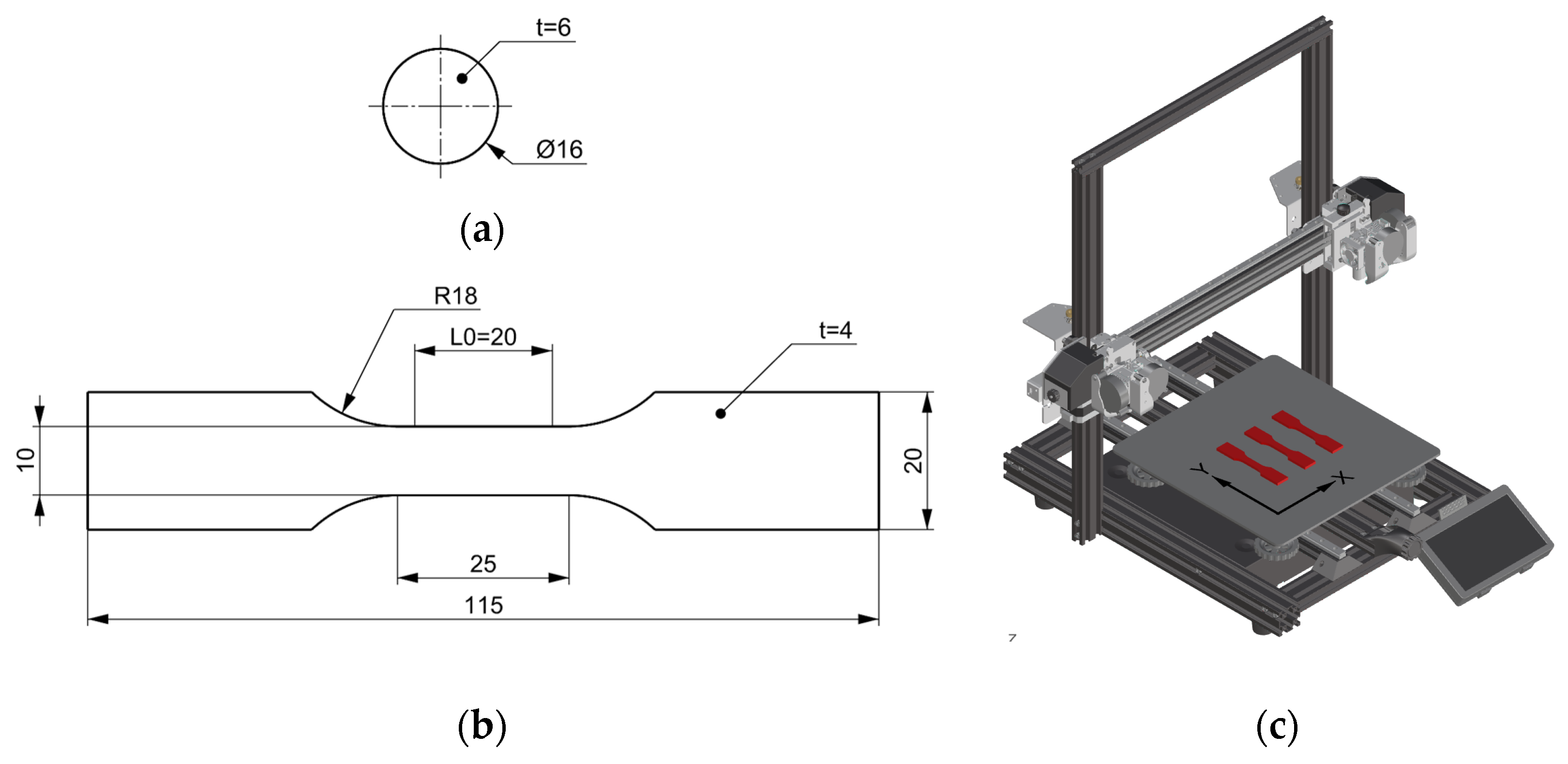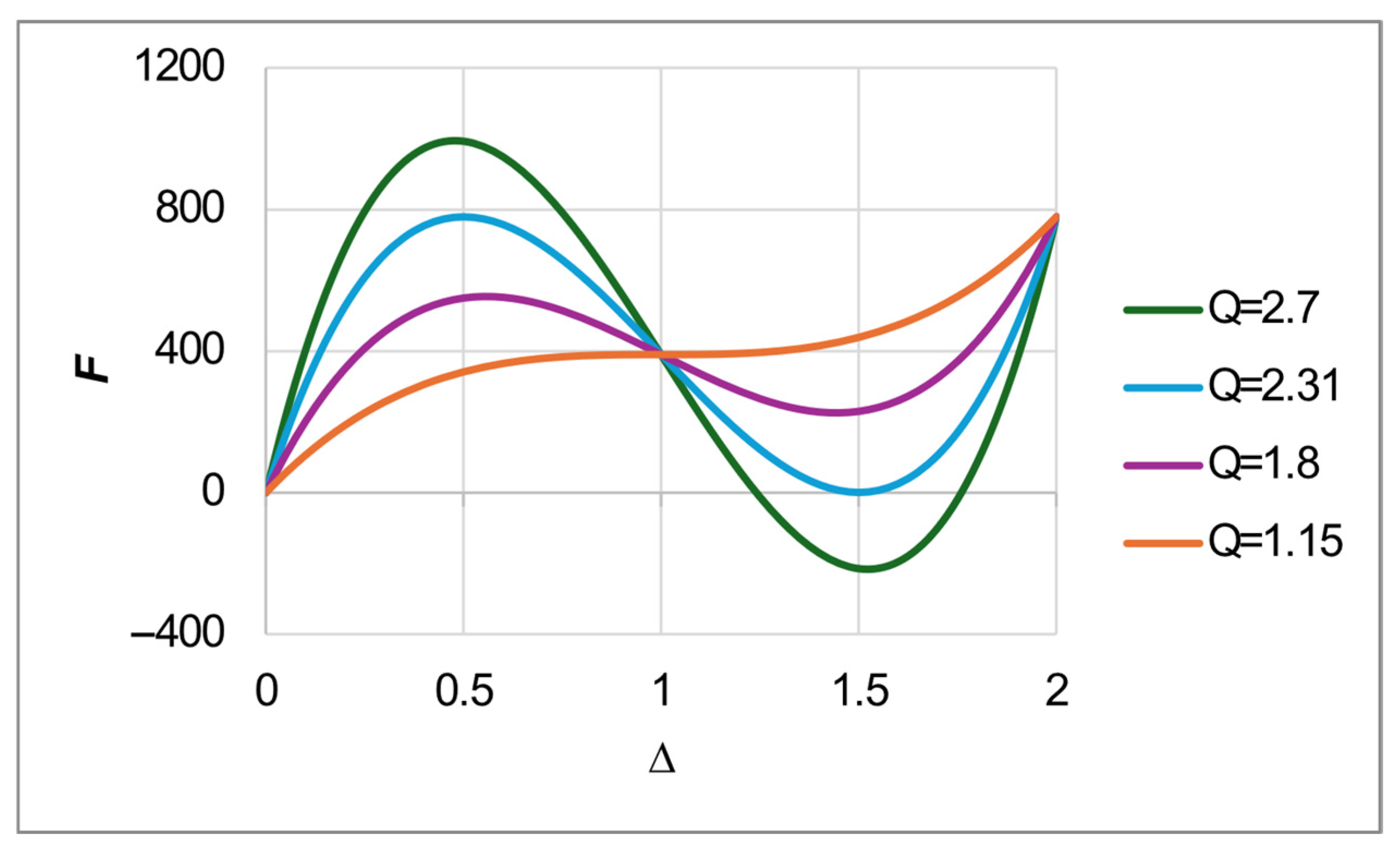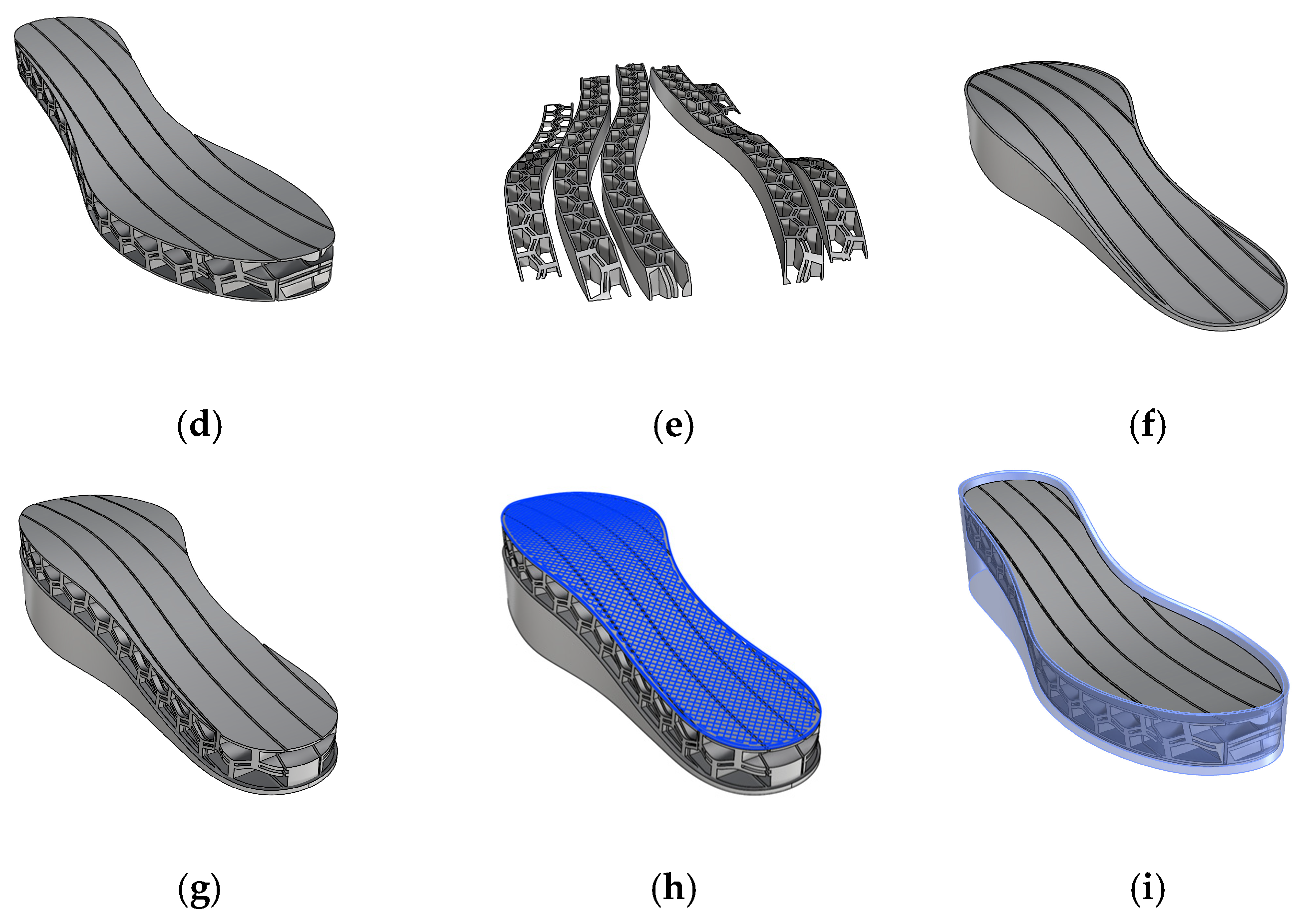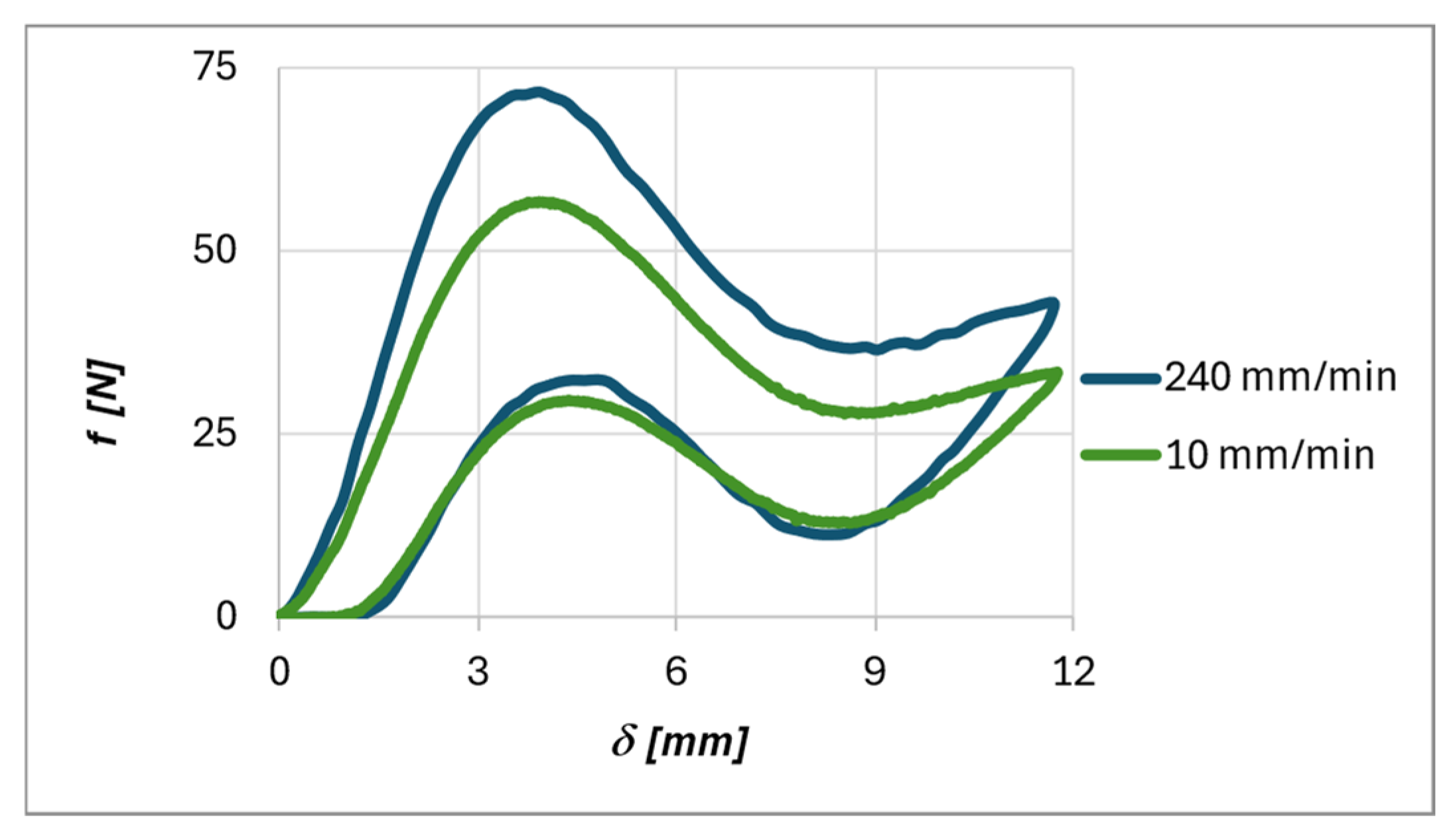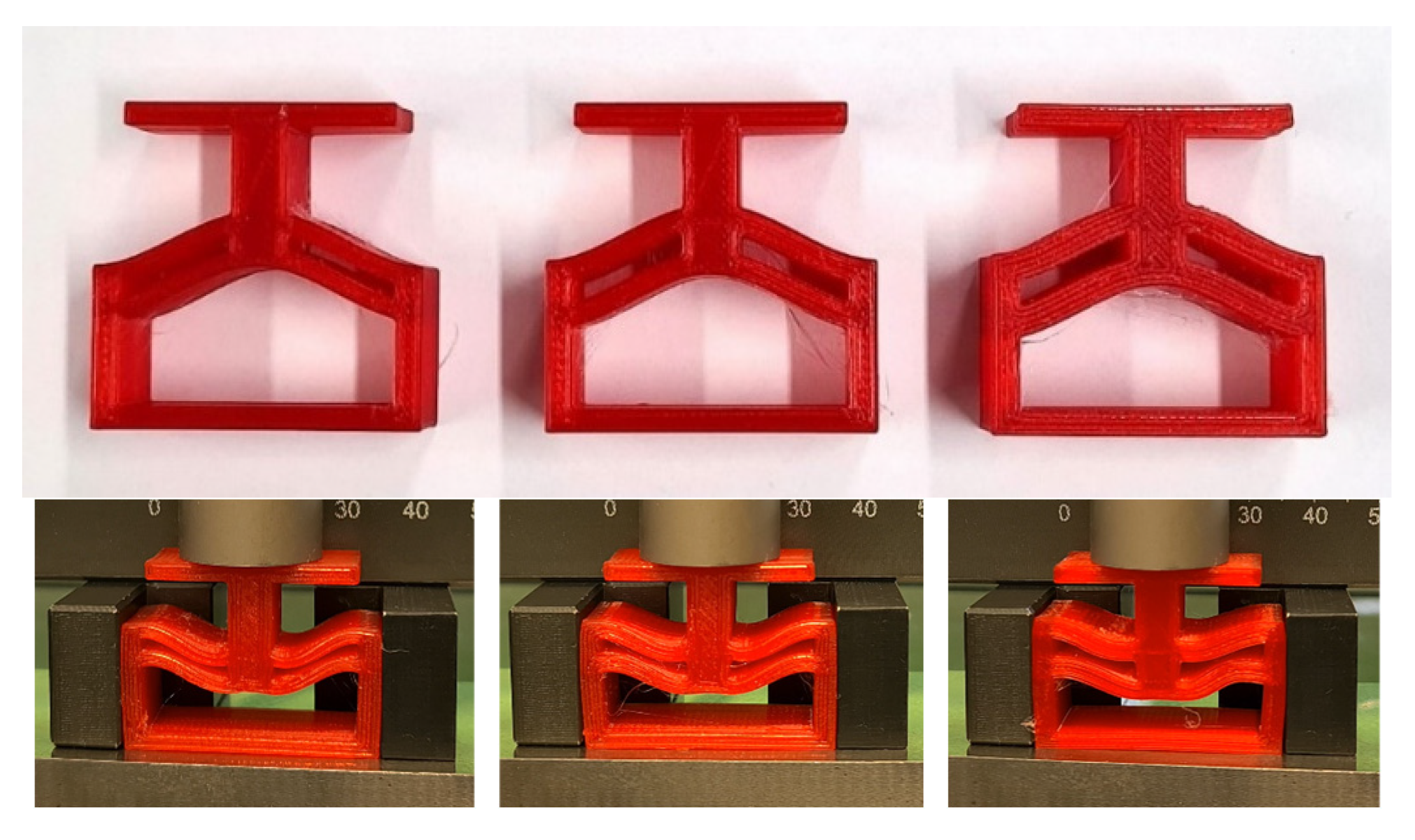To evaluate the mechanical response of the proposed structures, the results of the experimental test and analytical model are reported and compared in this section.
4.2. Cell Mechanical Properties
Figure 11 illustrates the behavior of the analytical model in terms of force and displacement, obtained by combining Equations (2), (3), and (5) for the case studies considered, while
Table 8 summarizes the main characteristics of the tested cells based on the analytical model. In this context, the force ratio,
, is also introduced, representing the ratio between the force decay and the maximum force, i.e.,
. It can be observed that increasing
leads to an increase in both
and
, while
decreases. An analysis of the relevant equations reveals that an increase in
results in an increase in
and
and a decrease in
. Notably,
is the only parameter that affects displacement, as greater values of
lead to larger deformations (see Equation (2)). As previously discussed, the bistability condition depends simultaneously on both
and
, through the parameter
. Among the cases presented, only the configuration t2.0−Q3.0 does not result in bistability. Moreover, increasing
and
, results in an increase in
and
, while
remains the same. Finally, increasing
results in a decrease in
and
, while
remains unchanged.
Figure 12 represents the force–displacement data obtained during the compression tests on the manufactured samples, while
Figure 13 shows the behavior of sample t2.5−Q2.4 at different loading rates.
Table 9 summarizes the most significant values from the tests presented in
Figure 12 and
Figure 13. As expected, during the loading phase, the curves show an initial segment with positive stiffness, followed by a region with negative stiffness, and then again, a segment with positive stiffness. A similar behavior is observed during the unloading phase, although the force values are lower for the same displacement, and a residual displacement is present when the force returns to zero. It is possible to observe that both the maximum force (
) and the minimum force (
) during loading are higher than those during unloading (
and
). The ratio between the maximum forces during loading and unloading increases with
t, with an average value of 52%. A similar trend is observed for the minimum forces. These differences are associated with the energy dissipated during the loading–unloading cycle, which is represented by the area enclosed in the loop shown in
Figure 12 and
Figure 13. This phenomenon is known as hysteresis.
Figure 12 also highlights that higher values of t and Q lead to higher force–displacement curves. In contrast, the differences between the curves at different loading rates are related to the material’s time dependence. As can be seen in
Figure 13, higher loading rates lead to higher forces. These phenomena are thoroughly documented in the scientific literature for other types of samples [
27].
Figure 14 illustrates the fabricated samples along with their deformation mechanism under compressive loading. As observed, unlike the idealized model, the vertical walls undergo lateral deformation despite the presence of vertical rigid guides. This is one of the factors contributing to the discrepancy between the experimental results and the analytical model. In fact, these undesired boundary conditions redistribute the strain energy, leading to lower measured peak forces. Although the experimental behavior aligns with the numerical model, the measured maximum force,
, is on average 47% lower than the theoretical prediction.
exhibits a similar behavior, showing an average reduction of approximately 48%, with a corresponding effect on
. The deviation in displacement corresponding to the maximum and minimum force is, on average, 17% and 9%, respectively. This result may be related to the definition of the starting point of the curve, which may exhibit a settling behavior of the specimen in its initial region. Furthermore, bistability is not observed in any of the experimental configurations. For midsole offloading, we seek a monostable, recoverable behavior so that after each walking step, the structure returns to its initial state without the application of negative external forces. Under the chosen material (TPU) and boundary conditions, the tested geometries exhibit a monostable response, ensuring reversible offloading and avoiding snap-through “locking.” Accordingly, the adopted Q values are appropriate for the target application, where a reliable reset to the initial configuration is required.
To strengthen interpretation, link observations to mechanisms, and provide actionable guidance for design and future optimization, it is worth noting that the analytical model assumes linear elasticity, whereas TPU [
27,
47]
- -
Exhibits nonlinear, large-strain elastomeric behavior.
- -
Displays a large hysteresis loop with residual strain upon unloading, which is only partially recovered over time.
- -
Shows time-dependent behavior; i.e., the material responds differently depending on the strain rate.
- -
Manifests Mullins-type softening, i.e., the stress–strain curve in the second cycle is significantly more compliant than that in the first, with stable curves typically observed after only four cycles.
Consistently,
Figure 10 exhibits nonlinear behavior,
Figure 12 and
Figure 13 show a large hysteresis loop with residual strain, and
Figure 14 presents time-dependent behavior where higher test speed leads to higher force and increased hysteresis. The study of the softening mechanism will be addressed in future work.
Despite the differences between the analytical model and the experimental data, the analytical model adequately captures the influence of the geometrical parameters on the maximum force. Therefore, the experimental results, potentially integrated with additional data, can be used to correct the model, enabling the design of midsoles that more accurately reflect actual conditions.
4.3. Model Behavior and Sensitivity Analysis for Parameter Selection
As discussed in
Section 3.3.3, the geometrical parameters influencing the analytical model are
and
. An analysis of the behavior of the critical pressure
p* based on these parameters allows for a better understanding of the phenomenon.
Figure 15 shows the behavior of
and
, as functions of
and
. It can be observed that increasing either
or
leads to an increase in
. Considering the experimental results, which show that the force decay is half the nominal value, it is reasonable to assume a value of
equal to 2.31. This corresponds to a theoretical
of 1 and an effective value of approximately 0.5.
Figure 16 shows the behavior of
δ* and
δmin as functions of
h and
t. These parameters mainly depend on
(see Equation (2)). The selected value of
Q leads to
Assuming
, the deformation at which the mechanism transitions to negative stiffness, Equation (7) yields
h = 3 mm. Moreover, according to Equation (8),
t = 1.3 mm.
Once the material is selected and
E is known, in this specific case derived from experiments (
E = 44.5 MPa), Equation (10) yields
L = 17.5 mm.
Figure 17 shows the behavior of
p* and
pmin, as functions of
and
, for
L = 17.5 mm and
E = 44.5 MPa. This analysis can be useful to confirm whether the selected pair of parameters meets the pressure threshold requirement, or to identify an alternative combination of
h and
t that satisfies the same condition.
Figure 18 presents the analytical model of the cell based on the calculated parameters, along with a hypothetical expected behavior derived from experimental results integrated into the model, which will be the focus of future work.
A sensitivity study was carried out to evaluate the effects on
p* of variations in the parameters influencing cell behavior in the vicinity of the selected values. The results are summarized in
Table 10. The parameters with the greatest influence on
p* are
h and
t: a 1% variation in h leads to a 5% change in
p*, while a 1% variation in
t results in a 4% change.
p* is proportional to
1/L4, as can be observed by analyzing Equation (10). A 1% variation in
L leads to a 2% change in
p*, while a 1% variation in
E results in a 1% change, due to its linear proportionality.

